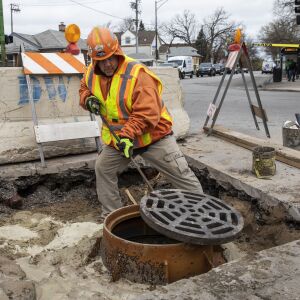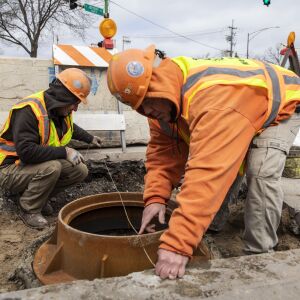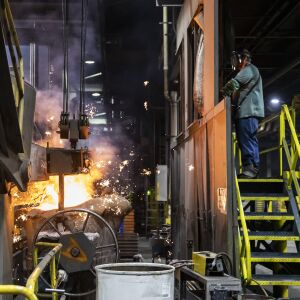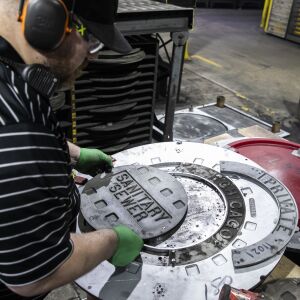
Most of us seldom notice them, even though they can brave the extremes of weather for 100 years while being run over by trucks without deteriorating, and we depend upon their steadfast operation to keep us from falling into open sewers.
They are literally everywhere, around the world and at our feet, on every block, every street corner: the manhole covers, stormwater intake grates, bumpy rectangles where the sidewalk slopes to meet the street (formally known as detectable warning plates) and other cast-iron infrastructure that help keep Chicago from reverting back to the swamp it was at its beginning.
“It’s stuff that’s always there, but no one thinks about it,” said Joe Falle, director of research and development and application engineering at Neenah Foundry in Neenah, Wisconsin, 190 miles north of Chicago, between Oshkosh and Appleton. “It doesn’t do anything special but cover a hole.”

Many, many holes. The city of Chicago Department of Water Management, which wrangles the city’s manhole covers, estimates there are about 148,000 sewer covers on Chicago streets, plus another 205,000 catch basins.
“We have a manhole cover down the middle of every street, going directly into sewers,” said Matt Quinn, deputy commissioner of the Department of Water Management. “Six catch basins per block and three manhole covers.”
Manhole covers are solid — to keep sewer odor from wafting up to the street. Catch basin covers have slats — to let stormwater in. And, in case you’re curious, no, gender neutrality has not reached this realm of society.
“Yes, we still call them ‘manhole covers,’ ” Quinn said. “Most people don’t care because it’s a cover over a sewer.”
But what a cover. Two feet across, about two inches thick, solid cast iron.
While there are other suppliers, many Chicago covers originate here, in the sprawling, loud Neenah Plant No. 2, the main facility of a company that has been producing cast-iron products for the past 150 years. Ever since William Aylward started the Aylward Plow Works in 1872. The company expanded from plow blades to sugar caldrons and barn door rollers. Alyward’s three sons entered the business, which added cast-iron stoves. In 1904, it began making manhole covers.
The casting process itself is ancient — thought to be introduced in China around the sixth century B.C. Though automated and mechanized, the basics haven’t changed: A pattern is pressed into sand to form a mold, then molten iron is poured into the mold. It cools, and the sand is washed away and the casting polished.
To create a Chicago cover — on average, about one day a month at Neenah is dedicated to making products for Chicago — first, a round steel pattern is retrieved from a narrow corridor that’s lined floor to ceiling with shelves. Think of it as a manhole cover library, containing about 1,000 models created over the years in Neenah’s extensive machine shop.
Some consider manhole covers beautiful: Photography books have been dedicated to them, and every Monday on Twitter Chicago manhole cover fans share pictures of unusual designs in what they call #ManholeCoverMonday.
Most of the patterns are steel, some aluminum or plastic. A few are so old they’re made of wood.
“We have rows and rows of these patterns,” Falle said. “Virtually all manhole covers, of different types and sizes.”
The patterns can last half a century, but being pressed into sand over and over eventually wears them down.

For today’s run of 10 Chicago covers, Moldline supervisor Aaron Christianson takes a pattern, removes a central circle reading “SANITARY SEWER” and replaces it with one reading “INFILTRATION BASIN.” He then unscrews the semi-circular metal plaque bearing the generic “PRIVATE” — sold to companies needing sewer covers — retrieves another semi-circular plaque reading “CHICAGO” from a shallow drawer and screws it into place.
The pattern is fixed into a machine that presses it into a bed of black sand: a firm mixture of sand, a type of clay called bentonite and something called “c-coal,” creating molds for the top of the cover. Another pattern will form the bottom of the cover. Then, the two mold frames are clamped together, the sand holding its shape even when flipped upside-down.
As this is done, across the factory floor, the iron that will go inside is readied. Almost 100% is recycled metal — for every 10 pounds of new iron created worldwide, six pounds of old iron is reused. The rusty scrap iron waits in huge heaps outside.
“A little bit of everything,” Falle said of the scrap iron.
There are brake drums, car frames and old Neenah products, like domed beehive grates and frames recovered from street repairs.













While the covers and frames — the round flange that the cover sits in — do not typically break or decay, the streets into which they are set certainly do.
“What happens with concrete and iron is they bond together really well when they pour concrete around the frame,” Falle said. “So getting it out and trying to chip off all that concrete is virtually impossible. It just isn’t worth the effort. Generally, when they redo a street, they put all new castings in.”

A powerful electromagnet on the end of a crane grabs masses of iron from atop the scrap piles and transfers them inside to be dropped into a blast furnace, where they are melted and refined.
Iron — chemical symbol Fe, short for the Latin word ferrum — is the fourth-most common element in the universe, produced by nuclear fire, such as within the burning sun. Iron is, in essence, star ash. The center of the earth is a sphere of solid iron, 760 miles across, heated to nearly 10,000 degrees but unable to melt due to the immense pressure. On the earth’s surface, iron is essential to all living things. Not only does it course through your veins, a major part of hemoglobin, helping your blood process oxygen, but it’s present in your flesh. Beef turns red when exposed to air because the iron in its myoglobin oxidizes: The alluring color of a rare steak is rust, basically.
The blast furnace cupola burns foundry coke and lime. The scrap iron melts and runs through the coke and lime. It picks up carbon from the coke. Cast iron is between 3% and 5% carbon. Steel is about 2% carbon but takes more extensive refining and thus is more expensive — about three times the cost.
“The advantage to iron is it’s fairly inexpensive to produce,” Falle said.

The blast furnace pours a glowing orange, lava-like stream of molten iron into a five-foot tall crucible called a transfer ladle. The enormous bucket is carried overhead on a track — “WARNING,” reads an orange sign. “MOLTEN METAL CROSSING.” The crucible is tipped into a holding furnace on the aptly named pour deck to transfer the liquid iron into the molds, which are held in metal frames known as flasks. Each mold passes on a conveyor underneath, and a spurt of hot iron pours into a round hole. The molds are then shunted aside, an array of gray rectangles cooling for two hours, each with a glowing orange eye where the iron poured in.
When cool, the new covers are flipped out of the flasks onto a shakeout, a machine that rattles away most of the sand, which falls into a pit to be reused.
The covers have selvage on their edges — like tabs on plastic model car parts. Those are knocked off with hammers by workers who use long hooks to draw the covers and grates toward themselves, then the covers go into a shot blaster that buffs them with steel shot to smooth off the burrs.
Any remaining nubs are ground away with an air-powered chipping tool. Chipping is hot, dirty work — the toughest job in the foundry — performed by employees wearing full body gear that resembles spacesuits.
“The grinding dust, from a safety standpoint, is not good to breathe in all day long,” Falle said.
A finished sewer cover weighs about 150 pounds, nowhere near the heaviest product Neenah makes, which are tractor weights. A tractor pulling a heavy thresher won’t have enough, ah, traction with the ground unless it has weight pushing its treads downward, such as a 1,800-pound Neenah tractor weight, which goes inside the rims of each massive wheel. The smallest product Neenah makes are pipe covers that weigh 10 pounds and are about the size of a saucer.
The manhole covers and grates begin to rust almost immediately, turning a bright orangeish-brown within minutes of coming out of the molds and being exposed to air. Ironically, this patina protects the metal. A steel grate would start out stronger but rust through and through and so might fail long before a cast-iron grate.
“Once it corrodes and gets rusty, it builds a silicate scale on the outside,” Falle said. “It essentially stops rusting. It’s inherently corrosive-resistant. It protects itself.”
How well? The company occasionally comes across covers still in the ground labeled Aylward and Sons — the company’s name for its first 50 years, before it was changed to Neenah Foundry in 1922.
“We’ll get calls about something, and we’ll go back, and the people that designed it are dead,” Falle said. The company keeps a library of catalogues, some nearly a century old, to use for product reference. “The product lasts so long. We go back with these catalogues. This is 1937.”
The new sewer covers are stacked outside to await delivery. The city of Chicago buys them for between $70 and $120 apiece and keeps some on hand. There are about 50 or so at the Department of Water Management’s South District storage yard in East Beverly, waiting to be used.
“Those 10 might be for a project mile of sewer mains,” Quinn said. “We’ll order covers for a specific project. It’s not like we have thousands of these things laying around.”

Shortly after these 10 covers were cast, a section of street at 93rd and Jeffery collapsed, leaving not a pothole but a pit.
“Over the course of time, layers of brick can fall apart,” Quinn said. “A lot of weight goes over those structures.”
Reports come in from 311 calls and are fed directly to the iPads of Department of Water Management investigators who drive around, visit problem areas and schedule repair work. This report came from the 7th Ward office, and the city set up a temporary concrete barrier. The next day, a crew came out for what they call “an emergency repair action” because it’s a main thoroughfare. The South District repairs about six catch basins a day.
The crew removed the chunks of broken pavement, then poured fresh concrete around a new frame, using string to make sure it’s about a quarter inch below the street itself to allow water to drain.
“Even an eighth would be good,” said Glenn Kubek, a laborer for the city for 29 years. “Bus stops and all that, where there’s a lot of traffic? It’s eventually going to start going down no matter what.”
Everything in infrastructure is a tradeoff. Older Neenah catch basin covers have wide slats, which lets more water through but also allows more debris to enter the sewers, where it clogs and must be sucked out by machine. New covers have thinner slats, keeping more debris out of the catch basins, which is good. They’re also kinder to bike tires and ADA-compliant. But thinner slats also mean the water goes in slower and is more easily blocked by debris that collects atop the covers.
The older covers used to be far heavier.
“These are much, much easier on the guys,” said John Gallagher, a general superintendent at the Department of Water Management.
The need to regularly clean and repair sewers is why covers aren’t welded on. But there is a downside there, too.
“Once in a great while, we do have theft,” Quinn said. “We work with the Chicago Police Department to make sure all recycling facilities know they’re not supposed to take them. You really can’t do anything with them if you steal them.”
In theory. The problem worsens if scrap metal prices rise. When prices peaked in 2008 and dealers were paying $10 to $20 a cover, Chicago could lose 40 covers a day. In 2020, Chicago police found a man with 31 covers in a pickup truck and charged him with felony theft.

At 93rd and Jeffery, the water management crew put the old lid back in place.
“This one still has some life in it,” Gallagher said.
The covers can be installed in several ways. There is the quicker, non-OSHA-approved method: Roll it next to the frame, and flip it in with a clang. Or the more involved, safer technique of nestling the lid in a saddle of wood and using a backhoe or forklift to set it gently down.
I asked one of the workers installing the new frame what caused the collapse.
“With the years,” said Juozas Macenis, a bricklayer originally from Lithuania. “Brick goes down. Moisture, especially salt, destroyed that. Salt water eats everything. Nothing is forever.”
But manhole covers come close. The workers at Neenah take pride in making something that not only does its job in such a public — if generally unnoticed — fashion but also endures through generations.
“That is the neat part of working here,” said Matt Lingnofski, 42, a journeyman pattern-maker creating new cover designs. “I’ve worked other places, and you don’t know what you’re building. Especially in a machine shop. You’re making machine parts, and you have no idea where it’s going to end up. The stuff we make here, it’s kinda neat we know where the final product is. It goes in a road. You might see it somewhere. The products we make, they’ll last longer than I will.”
And, yes, when traveling, he does check out the manhole covers.
“You can go anywhere in the country, almost anywhere in the world, and look down and find ‘Neenah Foundry,’ ” Lingnofski said. “You catch yourself doing it. I’ve done it everywhere I’ve been in the country and outside the country, I always look for Neenah Foundry products.”
And does your family give you trouble for it? I wondered, knowing the answer.
“Yeah, they pick on me,” he said, laughing. “Then, I catch them doing it as well.”

.




















